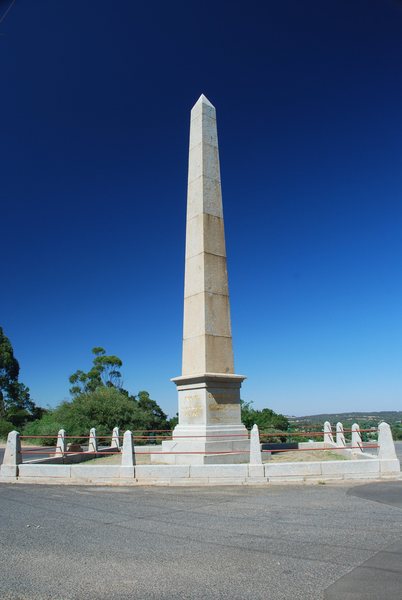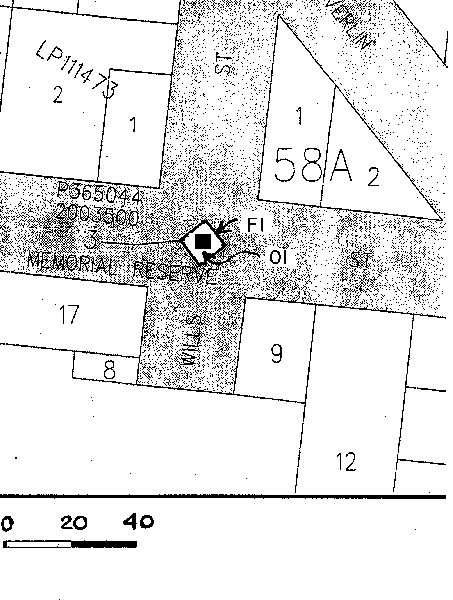Back to search results
BURKE & WILLS MEMORIAL OBELISK
WILLS STREET CASTLEMAINE, MOUNT ALEXANDER SHIRE
BURKE & WILLS MEMORIAL OBELISK
WILLS STREET CASTLEMAINE, MOUNT ALEXANDER SHIRE
All information on this page is maintained by Heritage Victoria.
Click below for their website and contact details.
Victorian Heritage Register
-
Add to tour
You must log in to do that.
-
Share
-
Shortlist place
You must log in to do that.
- Download report

BURKE & WILLS MEMORIAL OBELISK SOHE 2008



On this page:
Statement of Significance
What is Significant
In 1860 residents of Victoria and South Australia were engaged in funding competing expeditions in a race to cross Australia from south to north through the centre. The Great Northern Exploration Expedition led by Robert O’Hara Burke and William John Wills won the contest for Victoria in 1861. The expedition, which left Melbourne in early 1860, was funded by the Royal Society of Victoria, the Victorian Government and public subscriptions. From its inception the expedition was remarkable not only as a major event feted at every stopover but also as an embodiment of Victorian ideals of scientific inquiry, human enterprise and nation building.
Having successfully reached the Gulf of Carpenteria in February 1861, all but one of the expeditioners, King, perished in the return journey. The names of Burke and Wills became bywords of noble endeavour and self-sacrifice. The tragedy of the occasion, combined with its strange mixture of human strengths and flaws, chance and battle against the Australian environment resulted in their deaths being widely celebrated in high art, particularly verse and painting. These elements have ensured the event still lies deeply ingrained in the Australian psyche.
At the time Victorians regarded Burke and Wills as their State’s first great heroes and their deaths as a national disaster. Of the many cities and towns to erect memorials to Burke and Wills, Castlemaine was the first to act, not only in enthusiasm to honour the tragic events but to identify the town as the place of Burke’s last residence where he was Superintendent of Police. At first Castlemaine aspired to bury Burke but this was curtailed by a decision of Government that both heroes would be buried in Melbourne. A thousand people met at Castlemaine in November 1861 and decided to erect a 50ft high granite obelisk in memoriam. The bulk of the funds came from small subscriptions of less than a guinea so as to create a ‘people’s monument’. The government granted a site on top of a small hill east of the town centre and the obelisk and its fence were completed by July 1863. Inscriptions cut into the base of the obelisk record its origin through public subscription, the explorers’ achievement in being ‘The First To Cross The Continent of Australia’, Burke’s local connections and date of death, and the legend, ‘Melbourne to Carpenteria - Burke, Wills, Gray, King Survivor’.
How is it significant
The Castlemaine Burke and Wills memorial obelisk is of historical and architectural significance to the State of Victoria.
Why it is significant
The Castlemaine Burke and Wills memorial obelisk is of outstanding historical significance as the first monument erected in Victoria to honour the achievements of Burke and Wills. The State’s memorial, a heroic sculpture, was not completed until April 1865. Built of local granite, and positioned on a prominent hill overlooking the town, the obelisk mirrors the strength of colonial Victorians’ feelings at the time of the tragic events. The obelisk also complements a large range of contemporary civic and commercial buildings in the town, including the Market Building. The obelisk has architectural importance as a rare and large civic monument of this architectural form which derives from the renaissance use of obelisks standing on a moulded block base. The location of the obelisk on a prominent hill also follows renaissance traditions of their use as progressional markers in a city landscape.
In 1860 residents of Victoria and South Australia were engaged in funding competing expeditions in a race to cross Australia from south to north through the centre. The Great Northern Exploration Expedition led by Robert O’Hara Burke and William John Wills won the contest for Victoria in 1861. The expedition, which left Melbourne in early 1860, was funded by the Royal Society of Victoria, the Victorian Government and public subscriptions. From its inception the expedition was remarkable not only as a major event feted at every stopover but also as an embodiment of Victorian ideals of scientific inquiry, human enterprise and nation building.
Having successfully reached the Gulf of Carpenteria in February 1861, all but one of the expeditioners, King, perished in the return journey. The names of Burke and Wills became bywords of noble endeavour and self-sacrifice. The tragedy of the occasion, combined with its strange mixture of human strengths and flaws, chance and battle against the Australian environment resulted in their deaths being widely celebrated in high art, particularly verse and painting. These elements have ensured the event still lies deeply ingrained in the Australian psyche.
At the time Victorians regarded Burke and Wills as their State’s first great heroes and their deaths as a national disaster. Of the many cities and towns to erect memorials to Burke and Wills, Castlemaine was the first to act, not only in enthusiasm to honour the tragic events but to identify the town as the place of Burke’s last residence where he was Superintendent of Police. At first Castlemaine aspired to bury Burke but this was curtailed by a decision of Government that both heroes would be buried in Melbourne. A thousand people met at Castlemaine in November 1861 and decided to erect a 50ft high granite obelisk in memoriam. The bulk of the funds came from small subscriptions of less than a guinea so as to create a ‘people’s monument’. The government granted a site on top of a small hill east of the town centre and the obelisk and its fence were completed by July 1863. Inscriptions cut into the base of the obelisk record its origin through public subscription, the explorers’ achievement in being ‘The First To Cross The Continent of Australia’, Burke’s local connections and date of death, and the legend, ‘Melbourne to Carpenteria - Burke, Wills, Gray, King Survivor’.
How is it significant
The Castlemaine Burke and Wills memorial obelisk is of historical and architectural significance to the State of Victoria.
Why it is significant
The Castlemaine Burke and Wills memorial obelisk is of outstanding historical significance as the first monument erected in Victoria to honour the achievements of Burke and Wills. The State’s memorial, a heroic sculpture, was not completed until April 1865. Built of local granite, and positioned on a prominent hill overlooking the town, the obelisk mirrors the strength of colonial Victorians’ feelings at the time of the tragic events. The obelisk also complements a large range of contemporary civic and commercial buildings in the town, including the Market Building. The obelisk has architectural importance as a rare and large civic monument of this architectural form which derives from the renaissance use of obelisks standing on a moulded block base. The location of the obelisk on a prominent hill also follows renaissance traditions of their use as progressional markers in a city landscape.
Show more
Show less
-
-
BURKE & WILLS MEMORIAL OBELISK - History
Contextual History:History of Place: see statement of significanceBURKE & WILLS MEMORIAL OBELISK - Permit Exemptions
General Exemptions:General exemptions apply to all places and objects included in the Victorian Heritage Register (VHR). General exemptions have been designed to allow everyday activities, maintenance and changes to your property, which don’t harm its cultural heritage significance, to proceed without the need to obtain approvals under the Heritage Act 2017.Places of worship: In some circumstances, you can alter a place of worship to accommodate religious practices without a permit, but you must notify the Executive Director of Heritage Victoria before you start the works or activities at least 20 business days before the works or activities are to commence.Subdivision/consolidation: Permit exemptions exist for some subdivisions and consolidations. If the subdivision or consolidation is in accordance with a planning permit granted under Part 4 of the Planning and Environment Act 1987 and the application for the planning permit was referred to the Executive Director of Heritage Victoria as a determining referral authority, a permit is not required.Specific exemptions may also apply to your registered place or object. If applicable, these are listed below. Specific exemptions are tailored to the conservation and management needs of an individual registered place or object and set out works and activities that are exempt from the requirements of a permit. Specific exemptions prevail if they conflict with general exemptions. Find out more about heritage permit exemptions here.Specific Exemptions:Regular cleaning and weeding
-
-
-
-
-
FLOUR MILL
 Victorian Heritage Register H0395
Victorian Heritage Register H0395 -
BANK OF NEW SOUTH WALES
 Victorian Heritage Register H0131
Victorian Heritage Register H0131 -
FORMER CBC BANK
 Victorian Heritage Register H0712
Victorian Heritage Register H0712
-
'CARINYA' LADSONS STORE
 Victorian Heritage Register H0568
Victorian Heritage Register H0568 -
1 Alexander Street
 Yarra City
Yarra City -
1 Botherambo Street
 Yarra City
Yarra City
-
-












